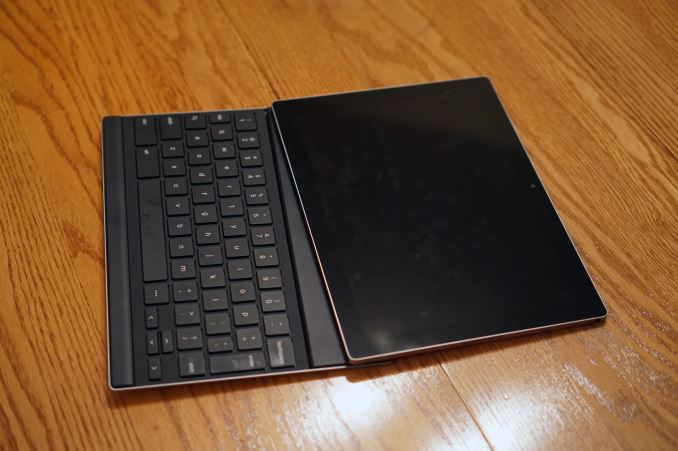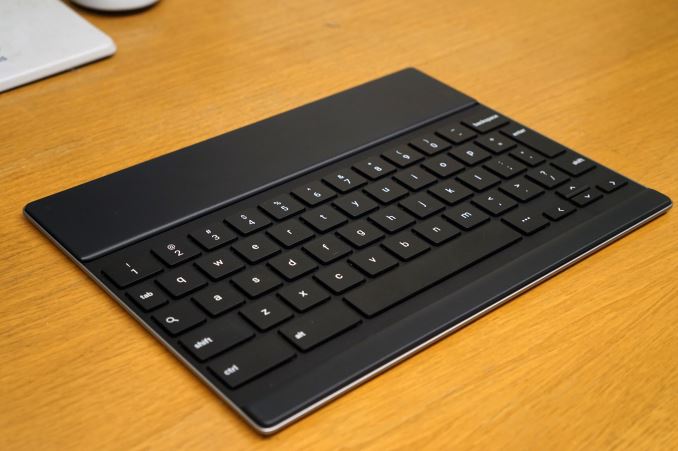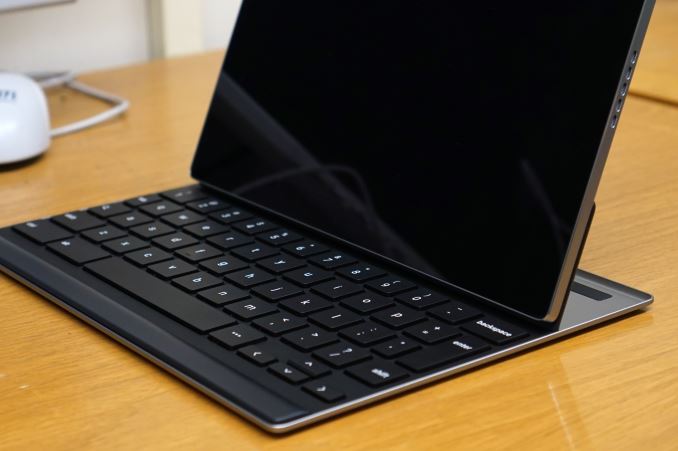The Google Pixel C Review
by Brandon Chester & Joshua Ho on January 25, 2016 8:00 AM ESTKeyboard
Part of the Pixel C’s appeal comes from the keyboard accessory. It isn’t included with the tablet itself, but this is true of most keyboards on tablets so it’s not as if the Pixel C is behind the competition in this regard. At $149 the keyboard is also well priced for one made out of machined aluminum, with full key travel and the Pixel C’s signature magnetic hinge.
Before talking about the keyboard itself, it’s probably a good idea to go over how that magnetic hinge works. The back of the Pixel C’s keyboard is a large aluminum flap with an equally large magnet on top. The best way you could describe the system is that this flap is connected to a very stiff hinge, which allows the flap to go to almost any angle up to about 85 degrees from the horizontal. The tablet has magnets embedded in its back which allow it to connect to this flap, and there’s enough strength in the connection to keep the tablet connected, as well as enough strength holding up the flap to prevent the mass of the tablet from causing it to start shifting back to a horizontal position. This system allows Google to give very fine angle adjustments without having to embed a kickstand in the Pixel C, and it’s quite a clever solution to the problem.
Of course, a unique keyboard solution does come with unique challenges. Obviously you end up with less space for the keyboard because the entire piece has to be the same size as the tablet, with a significant portion being dedicated to the magnetic flap. This is just an inherent result of the design, and while one could say it’s a waste, I would argue that the benefits of the system far outweigh this apparent downside.
The only real problem is training yourself to use the system correctly. When you put the tablet and keyboard together, you need to orient it with the tablet’s LED light bar on the same side as the keyboard’s space bar, or the keyboard won’t be able to charge using the Pixel C’s inductive charging. Unfortunately, this leads to some moments of confusion as you try to orient the tablet correctly after removing it. To split apart the keyboard and tablet Google recommends that you slide the two apart by pushing on the shorter sides of the keyboard and tablet. The first issue with this approach is that anything trapped between the keyboard and display is liable to absolutely ruin the glass, which has happened to my unit around some corners of the display.
The other issue is that once the two are separated you then need to remember to flip the tablet upward to put it in the right position to connect with the keyboard. While this seems like a natural motion, I find myself doing it incorrectly because even after sliding the two sections apart there’s still a magnetic attraction between the long edges of the tablet and keyboard, which causes me to favor rotating the tablet in order to separate them. In this case, the tablet ends up being upside down, and so you need to look at it and orient it such that the front-facing camera is on the top bezel before attaching it to the keyboard.
While some may feel that my issues working out the connection and disconnection of the keyboard are simply user error, it is worth noting that Google includes an enormous instruction sheet along with the Pixel C, and so confusion among users is clearly expected to some extent. I’ve gotten better at setting up the tablet in keyboard mode quickly, but it’s still not an action that has become a second nature to me.
Once you’ve set up the keyboard, you may notice something very familiar about it if you’ve had any experience with Google’s other Pixel products. The core part of the keyboard uses the exact same key size, pitch, and travel distance as the Chromebook Pixel. Google has shrunken the keys around the edges in order to match the keyboard to the Pixel C’s 10.2” display, but I haven’t found it to be much of a problem in use. On the contrary, I think the feel of the keyboard is great. The keys have a good tactile response, and the spacing is comfortable. In my eyes it definitely surpasses the iPad Pro’s Smart Keyboard by a large margin, although I’m not sure how well it compares to Microsoft’s Surface Type Cover.
Unfortunately, the keyboard becomes another area where the apparent mid-development switch to Android causes numerous issues. On the design side, you’ll notice that the keyboard follows the Chromebook Pixel in replacing the caps lock key with a search button. Right off the bat, I noticed a glaring issue with the implementation of this key. You can press search to open a search box anywhere, but I cannot find any way to close the search box if you open it by accident. If you open the search field you need to tap on the display to close it. There needs to be forgiveness in the design, either by making a backspace press when the field is empty close it, or by allowing you to close it by tapping search again with an empty field.
Android itself just doesn’t work very well with keyboards either. In fact, this implementation isn’t near as good as what I saw on the Dell Venue 10, and I didn’t think that provided a very good experience either. The big problem stems from the fact that Google hasn’t included proper navigation keys, which is more evidence that this device wasn’t ever meant to run Android in the first place. The omission of keys to trigger the standard home, back, and recent apps buttons is simply unacceptable. Google does have a help page online which lets you know the cryptic multiple key combos that perform these actions, but I don’t understand why a simple action like home needs to be activated by pressing search and enter, which are on entirely different sides of the keyboard. The same is true of back, which is search + backspace. Thankfully, Google does offer standard shortcuts in many of their apps, but the lack of navigational buttons on the keyboard is a big problem.
Ultimately, the Pixel C’s keyboard is a great piece of hardware, but Android doesn’t work very well with keyboards, and this keyboard in particular is ill suited to Android on top of that. Google has a very novel hinge implementation, and the inductive charging takes away the need to charge the keyboard, but many of the processes need to be streamlined and just generally made easier for the user to understand and get used to quickly. The tablet really needs to be able to attach onto and charge the keyboard without requiring a specific orientation, and the keyboard needs proper Android navigation shortcuts on top of Android simply needing much better keyboard support and applications to take advantage of one. I would love to see the ideas behind the Pixel C’s keyboard and hinge make it into keyboards from other manufacturers in the future, as well as future Android tablets that better deliver on promises of productivity abilities.














122 Comments
View All Comments
xthetenth - Monday, January 25, 2016 - link
I actually use the home screen a good bit on my phone but that's because I have a windows phone and it's actually useful. On tablets I'm more likely to use a broader and more varied set of apps and use the task switcher and apps list.Alexstarfire - Tuesday, January 26, 2016 - link
I use the home screen on my phone for just about everything really. I don't own a tablet but I can only imagine I'd do the same thing on it. I've got everything laid out on my home screen with folder(s) for grouping when necessary. Only time I go into the app drawer is to go to the gallery and to settings, and that's because I'm lazy and don't use them a whole lot. Task Switcher/Manager is used if I know the app I'm looking for was only used a couple apps ago. I'm not going to go scrolling through all my apps when it's easier to just go to the home screen and click the icon.Given that it's called the "Home Screen" I think you're not using your device to its potential if you are on your home screen so infrequently. To each his own though. :)
lilmoe - Monday, January 25, 2016 - link
This is a good iPad Pro competitor. But both aren't Surface competitors. Stop spreading stupidity.SaolDan - Monday, January 25, 2016 - link
Amen!osxandwindows - Monday, January 25, 2016 - link
I hope your joking.With all the problems and lack of apps, this can hardly be any sirius competition to the iPad pro.
Alexey291 - Saturday, January 30, 2016 - link
ipad pro? Wait wait someone actually compared ipad pro to a tablet? Oh boy.jjj - Monday, January 25, 2016 - link
lol i forgot that this thing exists.Google might as well give up instead of letting second graders do product design and Apple users set prices. Nobody has a decent tablet and they go on misguided explorations.
BrokenCrayons - Monday, January 25, 2016 - link
Android's problems and the overall lack of app quality are much more acceptable on a device that doesn't compete in higher price brackets. A $50 - 100 USD tablet are where glitches and errors like that belong rather than on something in the Pixel's price range. At that price, keeping productivity in mind as a primary usage scenario, it's probably a better idea to simply purchase a laptop.It's my personal opinion that Google's biggest mistake is fielding two distinctly different operating systems and then acting indecisively about which one to use on which product from the start. While Android is probably less elegant than Chrome, I think Google would help its own cause by abandoning Chrome and throwing that effort into making Android an OS that could operate effectively on phones, tablets, and small notebooks.
Murloc - Monday, January 25, 2016 - link
so basically converge like Microsoft did, only from an opposite place.We still have to see if that strategy works. Google has the advantage that everything started in their walled garden and so there's not the compatibility issues that microsoft has, they have a clean slate. But on the other hand, they'd have to make all the mouse and keyboard apps from scratch.
BrokenCrayons - Tuesday, January 26, 2016 - link
I don't think convergence is a good answer to the problem. In my opinion, there's very little of value that Chrome OS offers that's worth the effort of making the big muscle movements necessary to bring them over to Android. Having used x86 builds of Android on laptops previously, I think the shortcomings of the platform on notebook form factors become obvious when the user is compelled to make unusual gestures with a touchpad including things like clicking and dragging to scroll or being forced to deal with apps that rotate the screen without regard for the underlying platform. The former is something that needs a little work from Google in the gesture support department while addressing the latter is up to individual app developers to resolve. Having used several bluetooth keyboards paired to Android phones (along with the aforementioned x86 Android builds) in an effort to minimize the size and intrusiveness of computing tasks while improving flexibility through mobility, I argue that keyboard and mouse support is already pretty close to good enough based on my experiences and that very little work is required to get Android whipped into shape for laptop usage.In fact, all I'm really advocating is that Google dump Chrome OS because it seems like its mere existence is holding back development of Android. Simply tossing the entire thing into the trash and moving on is probably the best way to address the dysfunctions within the company over what OS to use on which device.